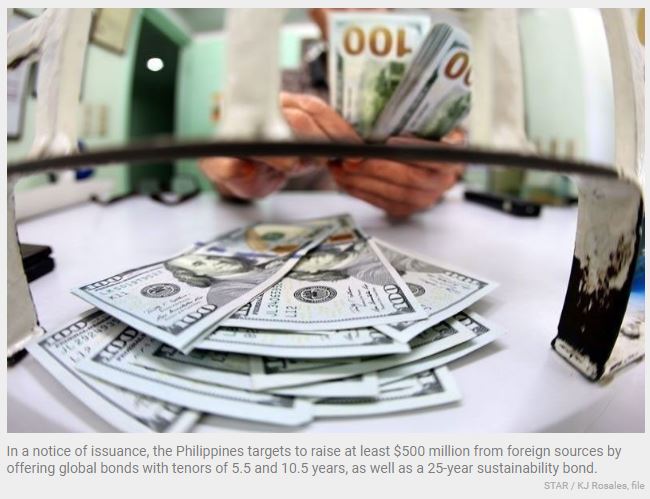Philippines: Government to borrow anew from foreign market
MANILA, Philippines — The Marcos administration will borrow at least $500 million, marking its second foray in the international debt market with the issuance of dollar and green bonds amid expectations of higher amounts to be raised as interest rates start to taper.
In a notice of issuance, the Philippines targets to raise at least $500 million from foreign sources by offering global bonds with tenors of 5.5 and 10.5 years, as well as a 25-year sustainability bond.
This marks the second global bond issuance of the Marcos administration since it assumed office. It made its debut in October 2022 when it raised $2 billion amid an environment of red-hot inflation and soaring interest rates.
Proceeds of both the 5.5- and 10.5-year bonds will be used for general budget financing while the green bond will be used to refinance assets in line with the country’s sustainable finance framework.
Rizal Commercial Banking Corp. chief economist Michael Ricafort said the latest dollar bond issuance was slated in a better timing as borrowing costs have already gone down by 1.2 percentage points from immediate highs posted in the latter part of 2022.
Ricafort said there is a need to finance the budget deficit this year and to have a supply of global bonds as the Philippines needs to hedge its source of financing.
Global bond issuances are a way to diversify the country’s funding sources and constantly provide liquidity of Philippine global bonds in the international market.
“The government tends to issue new global bonds in the early part of the new year, as consistently seen over the past five to 10 years even before the pandemic,” Ricafort said.
Global bond yields are slowly declining as the red-hot inflation in the US cools down because of declining oil prices and lower risks of recession.
On the domestic front, the central bank believes that the 8.1-percent inflation print in December was already the peak and that the headline rate should start to taper off this month.
The BSP also signaled its intention to moderate the pace of interest rate hikes.
Further, Ricafort said there is a need to hedge dollar and foreign borrowings amid foreign exchange risks involved, although there were earlier plans by the government to reduce offshore borrowings and increase domestic ones in the total financing mix.
Asked whether the amount to be raised this time will be higher than the $2 billion in October, Ricafort said that “it is possible.”
“There is even a plan for US dollar retail bond issuance worth about $3 billion with at least five-year tenor, so that is one signal or indication on the amount to be raised from global bond sale to be consistent,” he said.
Meanwhile, New York-based Moody’s Investors Service assigned senior unsecured ratings of Baa2 to the dollar-denominated bond offerings of the government.
“The bonds to be issued under the shelf program will constitute direct, unconditional and unsubordinated obligations of the government of the Philippines,” Moody’s said.
It added that the bonds would rank pari passu or on equal footing with all of the country’s current and future senior unsecured external debt obligations.
The rating also mirrors the credit rating of Baa2 held by the Philippines.
The notice listed BofA Securities Inc., Goldman Sachs, HSBC, Morgan Stanley, Standard Chartered Bank, UBS Group AG, and Deutsche Bank AG as joint lead managers and joint bookrunners for the issuance.
Source: https://www.philstar.com/business/2023/01/10/2236441/government-borrow-anew-foreign-market


 Thailand
Thailand




